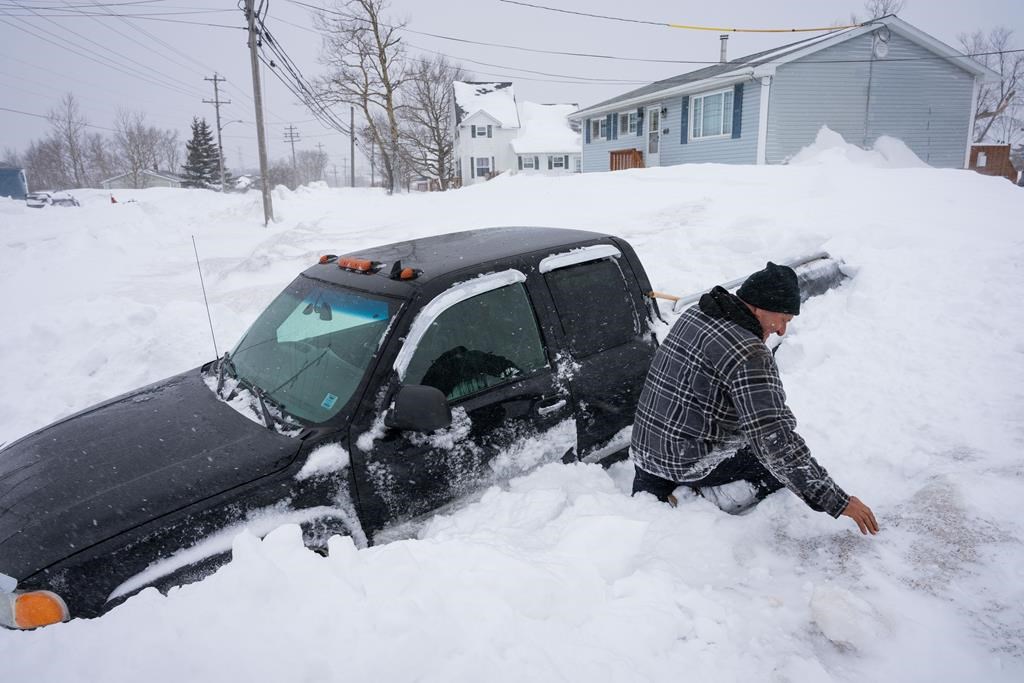‘It’s blowin’ a storm’: Another huge snowfall descends on Atlantic Canada

Posted Feb 14, 2024 06:45:40 AM.
Last Updated Feb 14, 2024 05:32:04 PM.
ST. JOHN’S, N.L. — A brawny nor’easter dumped up to 37 centimetres of snow on Nova Scotia on Wednesday before trudging to Newfoundland, where the wind picked up and a swirling snowfall enveloped much of the province.
Across the top of eastern and northeastern Newfoundland, up to 60 cm of snow was expected in communities from St. John’s in the east to the Bay of Exploits in the west, and the winds along the coast were expected to gust at 100 kilometres per hour until Thursday night.
Farther south, from the island’s Connaigre Peninsula to the southern Avalon Peninsula, between 15 and 45 cm of snow was in the forecast with winds gusting at 80 to 100 km/h along the coast.
On Newfoundland’s south coast near the town of Fortune, a fishing boat ran aground Wednesday morning in rough seas as the wind howled and the storm closed in.
During the day, the heaving water shoved the 18-metre Cape Cordell further onto the shore as crews aboard a Canadian Coast Guard ship and two local fishing boats failed to free the stranded trawler.
“Weather conditions have been terrible all day,” said Mark Gould, deputy superintendent of the coast guard’s search and rescue operations.
As of Wednesday night, four crew members and the day’s catch remained on board, Gould said. “Discussions are ongoing … on whether to evacuate them or whether it’s safer for them to stay on board.”
Fortune resident Barry Spencer said the boat was getting a beating as the tide went out Wednesday.
“She’s in pretty close to the beach, high-and-dry and the tide’s going down, and the wind is hitting her pretty hard — she’s rolling back and forth,” Spencer said in an interview. “There’s snow and driving snow and it’s blowin’ a storm.”
Deanne Hickman, the mayor of Fortune, said she was in St. John’s when she received reports about the mishap near the Ocean Choice International processing plant.
“It’s pretty scary, and we’ve got this snowstorm happening as well,” Hickman said. “From what I can gather, it was the wind that made them go aground.”
Meanwhile, photos posted online from eastern Newfoundland showed icy sea water seeping into the narrow streets in snow-covered Brigus, a picturesque town of about 700 people on Conception Bay. Mayor Shears Mercer said flooding from the bay has become increasingly common during big storms.
“It’s global warming,” said Mercer, a fisherman for more than 40 years. “The seas are getting higher and the weather is all upside down.”
He said Wednesday’s storm was the biggest since “Snowmaggedon,” which residents have come to call the massive snowstorm that shut down St. John’s for a week in 2020. But decades ago, he said, the province would get big storms more frequently.
By late Wednesday afternoon, the snow had become wet and heavy in St. John’s, where small drifts formed graceful curves in the middle of downtown streets.
Rhodie Smith was careful to push rather than lift his snow scoop as he cleared a walkway in front of a building on Duckworth Street. With more snow in the forecast until Thursday, the maintenance worker said his deliberate technique would serve him well.
“The key is to stay at it, go out multiple times, do your driveway every hour,” he said in an interview. “Trust me, it’ll be easier on your body.”
In northern Labrador, a prolonged period of snow was expected from Postville to Makkovik, where up to 100 cm was in the forecast for inland areas and over higher terrain until Saturday night or Sunday morning.
On Tuesday night, the storm slammed into Nova Scotia, forcing cancellations and delays.
The low-pressure system showed up less than two weeks after a previous nor’easter dumped up to 150 cm of snow on parts of Cape Breton. The unprecedented snowfall prompted a weeklong local state of emergency and a massive cleanup effort that was going well — until Wednesday when another 20 cm of fresh, wind-driven snow appeared. As a result, schools and provincial government offices were closed across Cape Breton.
According to preliminary data from Environment Canada, as of 8 a.m. Wednesday, 37 cm of snow had fallen over Shelburne along the province’s southwestern coast, 35 cm was reported from the Eskasoni First Nation in central Cape Breton and 32 cm fell on Liverpool in the southwest.
In the Halifax area, 29 cm fell at the airport, and between 20 cm and 35 cm was recorded in and around the port city as the storm pulled away in the morning.
Volunteer observers in the Halifax area reported there was already between 30 cm and 50 cm of accumulated snow on the ground, making for large snowbanks throughout the region.
Halifax residents were asked to stay off the roads Tuesday night and municipal transit buses were pulled from service around 8 p.m. as police reported a spike in fender-benders and stranded vehicles on the highways outside the city.
This report by The Canadian Press was first published Feb. 14, 2024.
— With files from Michael MacDonald in Halifax.
Sarah Smellie, The Canadian Press








